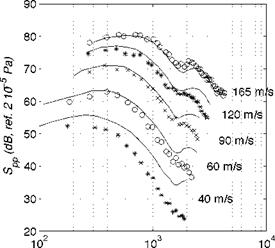Turbulence-Impingement Noise Results
The figure 18 reproduces turbulence-impingement sound spectra for a NACA-0012 airfoil embedded in grid-generated turbulence, as reported by Paterson & Amiet (1976). The airfoil is mounted between end-plates at the nozzle of an open-jet anechoic wind tunnel and the noise is measured in the mid-span plane. Model predictions are superimposed on the sound spectra for different flow speeds. The agreement is found very good at the highest speed whereas the sound is clearly overestimated at the lowest flow speeds. The same experimental protocol repeated on a smaller set-up with a thinner airfoil of maximum thickness 3% at three flow speeds provides the results reported next in Fig. 19. Obviously the overall sound level and frequencies both increase with increasing flow speeds but humps and dips are seen always at the same frequencies, at Helmholtz numbers close to 2 n and 4 n. The dips are attributed to interference fringes caused by chord-wise noncompactness and therefore do not depend on the flow speed (at least at the low Mach numbers investigated). They correspond to the same pattern illustrated in Fig. 7. A similar dip is observed in Fig. 18. But unlike the ones of the NACA-0012, the model predictions based on the same analytical formulation are now found very close to the measurements despite the low flow speeds. This difference is attributed to the thinner airfoil design, 3% against 12%. Various authors recognized that thick rounded leading edges have a reduced response to oncoming turbulence at sufficiently high frequencies. This is especially prominent for some cross-sections of wind-turbine blades,
|
|
Frequency (Hz)
Figure 18. Turbulence-impingement noise spectra of a NACA-0012 airfoil from Paterson & Amiet (1976). Gridgenerated turbulence, observer at 90° in the mid-span plane. c = 23 cm.
the relative thickness of which reaches 15% or 18%. The reduction occurs intuitively when the incident turbulent eddies are smaller than the airfoil leading-edge thickness or curvature radius. Such small eddies are deviated by the mean streamlines instead of being scattered at the edge. If Amiet’s theory is assumed to hold for vanishing thickness or at least as long as the characteristic lengths of the turbulence exceed the thickness at the leading edge, comparing the response of different airfoils to the same incident turbulence provides a way to quantify the reduction due to thickness effect.
Data gathered from various investigators are found to collapse reasonably, at least over an extended range of parameters, provided that they are plotted in a corrected form to account for the variety of experimental conditions, as shown in Fig.20 reproduced from Roger & Moreau (2010). The reduction is divided by the ratio (e/c) / (e/c)ref and plotted as a function of the variable f£/U0 where £ = (A/c)ref / (Л/c), the index ref standing for the NACA-0012 airfoil in the experiment of Paterson & Amiet (1976) taken as reference.
The amount of reduction in dB is almost proportional to thickness and to
 |
frequency. The reduction also depends on the experimental set-up, mainly the grid-mesh size used to generate the turbulent field. The reasonable collapse of the figure can be used to empirically correct analytical predictions based on a thin-airfoil assumption.
Globally, turbulence-interaction noise at any subsonic Mach number is well predicted by Amiet’s analytical model for velocity disturbance rates of less than 10%, relative thicknesses of a couple of percent, and moderate cambers. The mean load, or equivalently the actual angle of attack neglected in the linearized theories of unsteady aerodynamics, has no noticeable effect for a thin and slightly cambered airfoil over a large range of realistic values, provided that the oncoming turbulence is nearly homogeneous and isotropic. Recent developments also indicate that the precise design of an airfoil is more sensitive when the incident turbulence departs from ideal homogeneity and isotropy (Staubs et al (2008)).
|
reduction for thick airfoils in incident turbulence, according to various investigators. Oerleman’s and Olsen’s results reviewed by Roger & Moreau (2010). |















